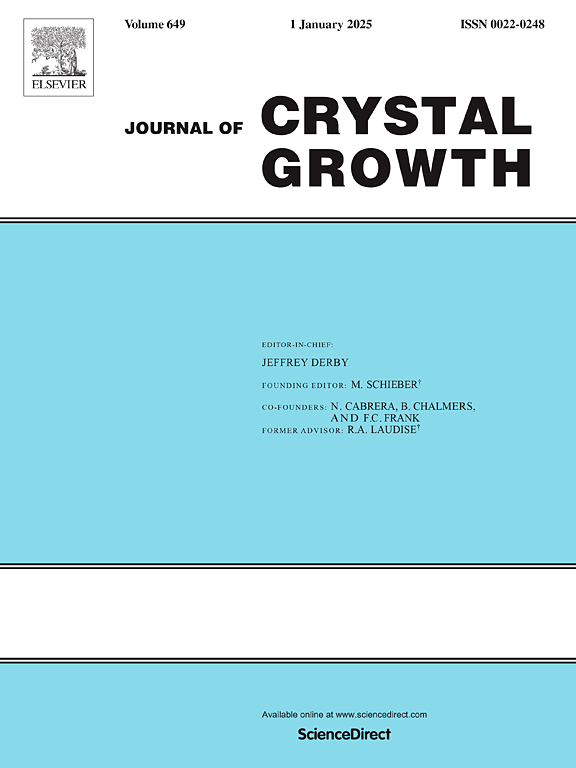Revealing the mixed-mode precipitation kinetics of γ′ with a modified Kampmann–Wagner numerical (KWN) model
IF 2
4区 材料科学
Q3 CRYSTALLOGRAPHY
引用次数: 0
Abstract
The precipitation kinetics of particles in solid-state has long been a topic of scientific and industrial interest due to their significant impact on the mechanical properties of Ni-based superalloys. Although numerous studies over the past decades have sought to understand the coarsening mechanism of precipitates, there remains a long-standing debate regarding the dominant mass transport mechanism-whether it is interface-controlled or matrix diffusion-controlled. A key challenge is that analytical theories of coarsening are only valid in the long-time regime, which is difficult to achieve experimentally. To address this, we have developed a modified Kampmann–Wagner numerical (KWN) model that incorporates both mass transport mechanisms. Using this precipitation model, we revisited experimental data from various Ni-Al model alloys at 823K and 1073K to clarify the dominant mass transport mechanisms from nucleation to coarsening. Our study demonstrates that a single mass transport mechanism cannot adequately reproduce the entire set of precipitation data. Specifically, the matrix diffusion mechanism aligns more closely with the early nucleation and growth stages but fails to account for the anomalous effect of increasing volume fraction on the coarsening rate. Conversely, while the interface-controlled mechanism fits the coarsening data better, it does not accurately represent the early nucleation and growth stages. These comparative results highlight the existence of a mixed-mode character throughout the entire precipitation process of particles, which is numerically captured by our modified KWN model.

用改进的坎普曼-瓦格纳数值(KWN)模型揭示γ′的混合模式沉淀动力学
固态γ′粒子的析出动力学长期以来一直是科学和工业感兴趣的话题,因为它们对ni基高温合金的力学性能有重大影响。尽管在过去的几十年里,许多研究都试图理解γ′沉淀的粗化机制,但关于主要的质量传递机制——是界面控制还是基体扩散控制——仍然存在长期的争论。一个关键的挑战是,粗化的分析理论只适用于长时间的制度,这是很难实现的实验。为了解决这个问题,我们开发了一个改进的Kampmann-Wagner数值(KWN)模型,其中包含了两种质量传递机制。利用这一沉淀模型,我们重新考察了不同Ni-Al模型合金在823K和1073K下的实验数据,以阐明从成核到粗化的主要质量传递机制。我们的研究表明,单一的质量输运机制不能充分再现整个降水数据集。具体来说,基体扩散机制与早期成核和生长阶段更接近,但不能解释体积分数增加对粗化速率的异常影响。相反,虽然界面控制机制更符合粗化数据,但它不能准确地代表早期成核和生长阶段。这些比较结果强调了γ′粒子在整个沉淀过程中存在混合模式特征,这一特征在我们改进的KWN模型中得到了数值捕捉。
本文章由计算机程序翻译,如有差异,请以英文原文为准。
求助全文
约1分钟内获得全文
求助全文
来源期刊

Journal of Crystal Growth
化学-晶体学
CiteScore
3.60
自引率
11.10%
发文量
373
审稿时长
65 days
期刊介绍:
The journal offers a common reference and publication source for workers engaged in research on the experimental and theoretical aspects of crystal growth and its applications, e.g. in devices. Experimental and theoretical contributions are published in the following fields: theory of nucleation and growth, molecular kinetics and transport phenomena, crystallization in viscous media such as polymers and glasses; crystal growth of metals, minerals, semiconductors, superconductors, magnetics, inorganic, organic and biological substances in bulk or as thin films; molecular beam epitaxy, chemical vapor deposition, growth of III-V and II-VI and other semiconductors; characterization of single crystals by physical and chemical methods; apparatus, instrumentation and techniques for crystal growth, and purification methods; multilayer heterostructures and their characterisation with an emphasis on crystal growth and epitaxial aspects of electronic materials. A special feature of the journal is the periodic inclusion of proceedings of symposia and conferences on relevant aspects of crystal growth.
 求助内容:
求助内容: 应助结果提醒方式:
应助结果提醒方式:


